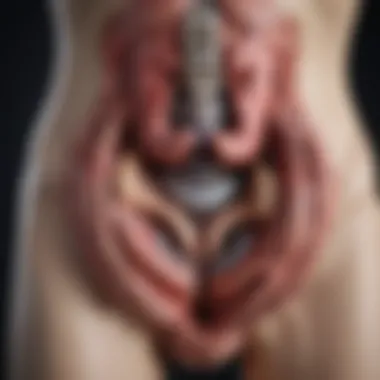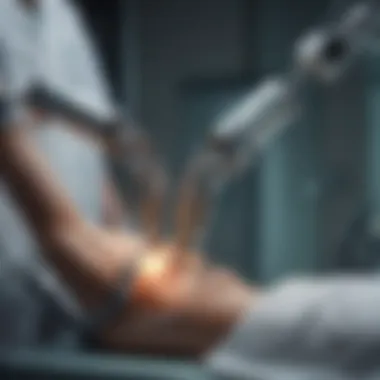Robotic Prolapse Surgery: Techniques and Benefits


Article Overview
Purpose of the Article
This article aims to provide a comprehensive examination of robotic prolapse surgery within the broader context of surgical interventions for pelvic organ prolapse. As prolapse presents significant physical and psychological challenges for patients, understanding robotic solutions becomes essential. Robotic surgery is characterized by precision, minimally invasive techniques, and enhanced visualization, leading to improved postoperative outcomes. Setting the stage for further discussion, this article will focus on relevant techniques, assess the advantages over traditional methods, and highlight implications for patient care.
Relevance to Multiple Disciplines
Robotic prolapse surgery touches on various fields, including gynecology, urology, and surgical technology. The implications extend beyond clinical settings to encompass research, education, and healthcare policy. As healthcare professionals seek to enhance treatment paradigms, understanding the advantages and limitations of robotic methods becomes crucial.
Research Background
Historical Context
The evolution of surgical interventions for pelvic organ prolapse has seen significant shifts. Traditional approaches, such as abdominal and vaginal surgery, laid the groundwork for more advanced techniques. The introduction of robotic-assisted surgery in the 1990s revolutionized this field, providing surgeons with a platform for increased control and efficiency. As studies began to highlight the safety and efficacy of robotic surgeries, the method gained traction among practitioners and institutions.
Key Concepts and Definitions
To navigate this article effectively, understanding key concepts is vital. Pelvic organ prolapse refers to the condition where pelvic organs slip from their normal position, often causing discomfort. Robotic surgery uses robotic systems, like the da Vinci Surgical System, allowing surgeons to perform complex procedures through small incisions with enhanced dexterity. Key terms that will be discussed include minimally invasive techniques, recovery time, and potential complications in robotic prolapse surgery.
Foreword to Robotic Prolapse Surgery
Robotic prolapse surgery stands as a significant advancement in the field of gynecological surgery. This modern approach incorporates robotic assistance to enhance surgical precision and minimize patient recovery time. As pelvic organ prolapse becomes a more recognized issue, understanding robotic interventions becomes essential for health care providers and patients alike. The intricate nature of pelvic anatomy and the variations in surgical techniques require a nuanced understanding, making the introduction to robotic prolapse surgery vital in contemporary medical discussions.
What is Pelvic Organ Prolapse?
Pelvic organ prolapse occurs when the pelvic organs, such as the bladder, uterus, or rectum, descend into or outside of the vaginal canal due to weakened pelvic floor muscles and tissues. This condition can result from various factors, including childbirth, obesity, and surgeries. Symptoms often include pressure in the pelvic area, urinary incontinence, and discomfort during intercourse.
People often do not seek help due to embarrassment or lack of awareness about treatment options. Awareness of pelvic organ prolapse is growing. This increase highlights the need for effective surgical solutions, especially those that enhance the quality of life for affected individuals. Understanding the condition is crucial, as it lays the groundwork for deeper discussions about surgical interventions.
Overview of Surgical Interventions
Surgical intervention for pelvic organ prolapse can vary widely, depending on the degree of prolapse and specific patient needs. Traditional surgical techniques often involve vaginal or abdominal approaches, which can be invasive and require longer recovery times. Robotic prolapse surgery introduces a minimally invasive technique, allowing surgeons to maneuver instruments with greater precision.
The benefits of robotic surgery compared to traditional methods include:
- Minimized Scarring: Smaller incisions lead to reduced scarring.
- Faster Recovery: Patients typically experience shorter hospital stays and quicker return to normal activities.
- Enhanced Visualization: Robotic systems provide 3D views of the anatomy, aiding in surgical accuracy.
Understanding the various approaches available for prolapse treatment emphasizes the significance of robotic surgery. It not only offers promising results but also represents a leap toward addressing the needs of patients seeking effective repairs for their conditions. Continual advancements in robotic surgical technology suggest a bright future for prolapse treatments.
Robotic Surgery: A Technological Perspective
Robotic surgery represents a significant leap forward in the field of medicine, particularly in the context of prolapse treatment. The amalgamation of technology and surgical precision has revolutionized how procedures are performed. Understanding this technological perspective is crucial for evaluating the efficacy, benefits, and challenges of robotic prolapse surgery.
Preamble to Robotic Systems
Robotic systems in surgery create a paradigm shift in operative techniques. These systems facilitate minimally invasive procedures through enhanced visualization and control. Surgeons operate the robotic arms via a console, allowing for precise movements that are often difficult to achieve through traditional methods.
This approach is important in prolapse surgery, where delicate maneuvers are essential. The 3D visualization provided by robotic systems, such as the da Vinci Surgical System, enables surgeons to see the surgical site in high detail. Enhanced flexibility and range of motion further contribute to a less traumatic surgical experience for patients.
Surgical Robot Components and Functionality
Surgical robots consist of multiple critical components that work synergistically to enhance surgical outcomes. Key elements include:
- Robotic Arms: These instruments can perform intricate movements, mimicking the dexterity of human hands.
- Camera System: A high-definition 3D camera offers a magnified view of the surgical field, which is crucial for precision.
- Instruments: Specialized instruments designed for specific tasks can be introduced through small incisions, reducing recovery time and minimizing scarring.
The functionality of these components ensures that each aspect of the procedure is executed with utmost precision. The continuous feedback from the robotic system can also assist surgeons in making real-time decisions, further enhancing surgical safety and efficacy.


"Robotic surgery represents a fusion of engineering and medicine aimed at improving patient care through technological innovation."
"Robotic surgery represents a fusion of engineering and medicine aimed at improving patient care through technological innovation."
Techniques in Robotic Prolapse Surgery
The realm of robotic prolapse surgery encompasses various innovative techniques that significantly enhance surgical outcomes. Understanding these techniques is fundamental to appreciating the overall efficacy of robotic surgery in addressing pelvic organ prolapse. Each approach brings forth unique advantages and considerations that involve the surgeon's skill set as well as the patient's specific condition. A careful examination of these surgical techniques sheds light on their potential to improve patient care and surgical outcomes.
Transabdominal Robotic Approaches
Transabdominal robotic techniques are pivotal in the surgical management of prolapse. This approach involves accessing the pelvic organs through abdominal incisions, which allows for greater visibility and access. Surgeons can utilize sophisticated robotic instruments to perform dissections and reconstructions with higher precision compared to traditional methods.
The advantages of transabdominal approaches include:
- Reduced blood loss: The robotic system minimizes trauma to surrounding tissues, resulting in lower intraoperative hemorrhage.
- Enhanced visualization: High-definition, three-dimensional imaging provides surgeons a clear view of complex anatomy.
- Greater dexterity: Robotic arms offer a range of motion that surpasses that of the human hand, allowing for more intricate maneuvers.
However, these techniques also necessitate careful consideration of patient factors, such as BMI or pre-existing conditions, which may impact surgical decisions.
Vaginal Robotic Techniques
On the other hand, vaginal robotic techniques present an alternative approach where access is gained through the vaginal canal. This method ensures that the operation remains minimally invasive, which is preferred by many patients due to less postoperative pain and quicker recovery times.
The key advantages of vaginal robotic techniques include:
- Shorter recovery period: Many patients experience a significantly faster return to normal activities compared to traditional abdominal approaches.
- Less scarring: Since the surgery is performed internally, external incisions are typically avoided, resulting in minimal visible scarring.
- Applicable for specific types of prolapse: Certain prolapse types may respond more favorably to this method, depending on the individual anatomy.
Such advantages make vaginal robotic techniques appealing for both patients and surgeons, but they also require a careful patient selection process to ensure optimal results.
Learning Curve and Skill Acquisition
The transition to robotic techniques introduces a learning curve for many surgeons. Acquiring proficiency in robotic surgery demands not only technical skills but also an understanding of the robotic system's mechanics and fluidity in movement. Consistent practice and experience play crucial roles in overcoming the initial hurdles associated with robotic surgery.
Factors influencing the learning curve include:
- Familiarity with traditional techniques: Surgeons well-versed in laparoscopic surgery may more swiftly adapt to robotic systems than those coming from open surgical backgrounds.
- Training programs and simulators: Engaging in structured training programs can accelerate the process of mastery. Simulation exercises allow for practice without patient risk.
- Ongoing mentorship and collaboration: Partnering with experienced robotic surgeons can provide valuable insights and speed up skill acquisition.
As techniques evolve, the importance of continuous education and adaptation to new technology cannot be overstated in the context of robotic prolapse surgery.
Benefits of Robotic Prolapse Surgery
Robotic prolapse surgery presents various advantages over traditional surgical methods. Understanding these benefits is crucial for healthcare professionals, patients, and researchers. Patients often seek effective solutions to address pelvic organ prolapse, and robotic surgery offers an innovative approach. The increasing adoption of robotic systems in surgical settings highlights the importance of knowledge on this topic. Below, we explore key benefits that robotic prolapse surgery brings.
Minimally Invasive Nature
One of the most significant advantages of robotic prolapse surgery is its minimally invasive nature. This technique allows surgeons to perform complex procedures through smaller incisions compared to open surgery. The advanced robotic instruments can navigate the tight confines of the pelvic region, reducing damage to surrounding tissues. Since the surgeries are less invasive, patients experience less postoperative pain. In addition, recovery is commonly quicker than traditional methods.
- Less blood loss during the procedure
- Reduced postoperative discomfort
- Smaller scars due to minimal incisions
These aspects contribute to an overall better patient experience. The minimally invasive nature also supports improved cosmetic outcomes, which many patients consider important. It is necessary to emphasize how this leads to greater patient satisfaction.
Enhanced Precision and Control
Another key element of robotic prolapse surgery is the precision and control it offers. With robotic systems, surgeons can operate with enhanced dexterity. The instruments respond to the surgeon's hand movements, providing excellent precision during delicate procedures. This level of control leads to better placement of sutures and minimizes the risk of complications, such as bleeding or infection.
Surgeons benefit from 3D visualization, which improves depth perception and clarity of the surgical field. This technology allows them to visualize intricate structures within the pelvic cavity more accurately. Overall, practitioners can achieve more favorable surgical outcomes when performing robotic prolapse procedures.
Improved Recovery Times
Robotic prolapse surgery generally leads to improved recovery times. Patients often report returning to their daily activities sooner than those who undergo traditional surgery. The combination of reduced tissue trauma and effective surgical methods contributes to faster healing processes. Typically, patients can anticipate shorter hospital stays and quicker resumption of regular activities.


Key points regarding recovery include:
- Patients may experience faster resolutions of symptoms like pain and discomfort.
- Shorter overall time off from work or daily routines.
- Reduced incidence of complications like infections, leading to a smoother post-operative journey.
Improved recovery times not only enhance patient satisfaction but also potentially reduce healthcare costs associated with prolonged hospital stays.
Improved recovery times not only enhance patient satisfaction but also potentially reduce healthcare costs associated with prolonged hospital stays.
Risks and Considerations
Understanding the risks and considerations associated with robotic prolapse surgery is crucial. Like any surgical procedure, robotic surgeries come with inherent risks that need careful evaluation. The benefits of robotic interventions are often highlighted, but it is equally important to address the potential complications and to ensure that suitable candidates undergo the procedure. This ensures the overall effectiveness and safety of the treatment.
Potential Complications Post-Surgery
Every surgical procedure has its risks, and robotic prolapse surgery is no exception. Potential complications can range from minor to more severe issues. Some of the more common post-surgery complications include:
- Infection: As with any surgical procedure, there is a risk of infection at the incision sites. This can lead to prolonged recovery and additional treatments.
- Hemorrhage: Bleeding can occur during or after surgery. While robotic surgery typically minimizes blood loss, there remains a risk of significant hemorrhage that may necessitate blood transfusions.
- Bladder or Bowel Injury: The proximity of surgical instruments to the bladder and bowel can sometimes lead to unintended injuries. Such injuries can result in complications requiring additional procedures to repair.
- Urinary Retention: Some patients may experience difficulty urinating after surgery. This may be temporary but can also lead to the need for catheterization during recovery.
- Recurrence of Prolapse: In some cases, the prolapse may recur despite surgical intervention. This is an essential consideration for patients and surgeons alike when discussing expected outcomes.
Awareness of these complications enables both patients and practitioners to engage in informed discussions, outlining the potential risks versus benefits of robotic prolapse surgery. Careful monitoring and post-operative follow-ups can help mitigate these risks.
Patient Selection Criteria
Selecting appropriate candidates for robotic prolapse surgery is essential to ensure optimal outcomes. Certain factors determine whether a patient is suitable for this type of intervention. Important criteria include:
- Severity of Prolapse: Patients with moderately to severely symptomatic pelvic organ prolapse are typically considered ideal candidates for this surgery, especially when conservative treatments have failed.
- General Health Status: Evaluating the overall health of a patient is vital. Those with serious comorbidities or contraindications to surgery may not be suitable candidates.
- Age and Activity Level: Considerations regarding age and general activity level can impact recovery and long-term outcomes. Younger, more active individuals often fit the criteria better, though age alone should not be a disqualifying factor.
- Expectations and Understanding: It is crucial that patients have realistic expectations about the surgery. Those who clearly understand the risks, benefits, and potential outcomes are better prepared for the surgery journey.
In summary, the success of robotic prolapse surgery can hinge on careful patient selection. Both potential complications and the criteria for selecting patients should be considered thoughtfully to enhance the likelihood of successful surgical outcomes.
Outcomes of Robotic Prolapse Surgery
The outcomes of robotic prolapse surgery are critical for understanding the impact of this advanced surgical intervention. As healthcare continues to evolve, evaluating the effectiveness of robotic techniques becomes essential. This section delves into the short-term and long-term results of robotic prolapse surgery, alongside an assessment of quality of life for patients who undergo these procedures. Knowing what to expect from surgery can instill confidence in patients and guide practitioners in making informed decisions.
Short-Term and Long-Term Results
Short-term outcomes of robotic prolapse surgery primarily focus on surgical success, complication rates, and recovery time. Patients often experience less pain and may spend less time in recovery rooms compared to traditional surgical procedures. The minimally invasive nature of robotic surgery allows for smaller incisions, which typically results in reduced scarring and faster initial recovery. Many patients can resume normal activities within a few weeks.
On the other hand, long-term results are equally important in assessing the sustainability of surgical success. Studies have shown that many patients retain improved pelvic support and quality of life several years post-surgery. Recurrence of prolapse remains a concern, but data indicates a lower incidence rate with robotic techniques when compared to conventional methods. Annual follow-ups help to monitor any recurrence and allow for timely interventions if necessary.
"Studies show robotic surgery not only enhances initial recovery but also contributes to longer-lasting results in managing pelvic organ prolapse."
"Studies show robotic surgery not only enhances initial recovery but also contributes to longer-lasting results in managing pelvic organ prolapse."
Quality of Life Assessments
Quality of life (QoL) assessments are a crucial aspect of evaluating outcomes for patients undergoing robotic prolapse surgery. Beyond the physical aspects of surgical recovery, it's important to assess how these interventions affect daily living. Tools like the Pelvic Floor Distress Inventory (PFDI) and the Pelvic Floor Impact Questionnaire (PFIQ) are commonly used to measure QoL improvements.
Patients frequently report significant enhancements in comfort and functionality after surgery. This includes reduced symptoms such as urinary incontinence and pelvic pressure. Moreover, many patients mention improvements in their emotional well-being, self-confidence, and ability to participate in social and physical activities.
It's essential to understand that not all patients experience the same level of improvement. Factors such as pre-existing health conditions, the extent of the prolapse, and individual patient expectations can influence outcomes. Therefore, tailored assessments are imperative for each patient, allowing for comprehensive care and a clear understanding of potential benefits from robotic surgery.
Comparative Analysis: Robotic vs. Traditional Surgery
In the realm of pelvic organ prolapse treatment, understanding the differences between robotic and traditional surgical methods is vital. The choice between these types of surgeries can significantly impact patient outcomes, recovery times, and overall satisfaction. The analysis sheds light on how robotic surgery is changing the landscape of surgical treatment for prolapse conditions. It is essential to compare technical aspects, evaluate patient experiences, and assess satisfaction levels with both approaches. This comparison acts to inform healthcare providers and patients alike about their options, ensuring well-informed decisions.
Technical Comparisons
Robotic surgery relies on advanced technology that enhances precision during surgical procedures. The da Vinci Surgical System is a prime example of this technology, featuring robotic arms controlled by a surgeon through a console. This setup allows for three-dimensional images and magnification, offering a clearer view of the surgical site compared to traditional techniques.


In contrast, traditional surgery generally involves direct visualization through open methods or laparoscopic techniques. Although laparoscopic surgery is less invasive than open surgery, it does not provide the same level of magnification or range of motion as robotic systems.
Key technical advantages of robotic prolapse surgery include:
- Enhanced precision: Robotic instruments offer greater dexterity, enabling surgeons to work in tight spaces with more stability.
- Reduced blood loss: The minimally invasive techniques employed often lead to lower blood loss compared to traditional methods.
- Shorter hospital stays: Patients often experience quicker recoveries, implying less time in the hospital after surgery.
Patient Satisfaction and Experience
Patient satisfaction is a crucial element in evaluating surgical outcomes. Studies indicate that those who undergo robotic prolapse surgery report higher satisfaction levels compared to those who opt for traditional approaches. The reasons for this difference may include:
- Less postoperative pain: Patients frequently report experiencing less pain following robotic surgery, which allows them to return to normal activities sooner.
- Faster recovery: Quicker recovery times have a significant psychological impact on patients. Feeling better sooner can lead to improved overall satisfaction.
- Improved quality of life: Many patients express a stronger sense of overall well-being after surgeries with robotic assistance due to faster functional recovery.
"Robotic surgery tends to enhance patient comfort during recovery, making for a smoother transition back to everyday life."
"Robotic surgery tends to enhance patient comfort during recovery, making for a smoother transition back to everyday life."
Ultimately, patients considering surgery for pelvic organ prolapse must weigh these technical and experiential factors carefully. It is crucial for them to engage in detailed discussions with their healthcare providers to determine the most appropriate surgical option for their unique circumstances.
Future Directions in Robotic Prolapse Surgery
The field of robotic prolapse surgery is evolving rapidly, driven by technological advancements and increasing demand for minimally invasive procedures. As the understanding of robotic systems improves, the future of this surgical method promises enhanced outcomes for patients and clinicians alike. Examining the forthcoming directions in robotic prolapse surgery illuminates not just its benefits but also the considerations that shape its trajectory.
Advancements in Robotic Technology
With continuing developments in robotic technology, various innovations stand to benefit robotic prolapse surgery. The integration of artificial intelligence offers significant potential. Machine learning algorithms can analyze large datasets, improving surgical planning and outcomes by personalizing procedures for individual patients. Robotic platforms are also becoming more sophisticated, providing enhanced visualization through high-definition imaging and 3D capabilities. This affords surgeons greater precision.
Furthermore, miniaturization of robotic components is crucial. Smaller robotic arms allow for less invasive procedures while maintaining efficiency. This minimizes trauma to surrounding tissue and potentially decreases recovery time. The advent of haptic feedback in robotic instruments can significantly elevate surgical performance, enabling surgeons to gauge tissue resistance similar to traditional methods.
The following points summarize advancements in technology:
- Integration of Artificial Intelligence: Personalization of surgical techniques through data analysis.
- Enhanced Visualization: HD and 3D imaging for better surgical accuracy.
- Miniaturization: Smaller robotic arms lead to lower invasiveness and faster recovery.
- Haptic Feedback: Improves surgical precision by mimicking tactile sensation.
"The technological landscape in robotic prolapse surgery is not static; it is dynamic and ever-improving. Those adaptations will ensure better patient outcomes."
"The technological landscape in robotic prolapse surgery is not static; it is dynamic and ever-improving. Those adaptations will ensure better patient outcomes."
Research Trends and Ongoing Studies
Current research in robotic prolapse surgery focuses on various aspects, providing insights into efficacy, safety, and long-term outcomes. Clinical trials are exploring different surgical techniques, comparing them with conventional methods to ascertain effectiveness. The studies aim to establish a robust evidence base to recommend best practices in robotic prolapse surgery.
Patient-reported outcomes are gaining importance. The emphasis on quality of life signifies a shift from merely operative metrics. Research assesses how patients return to daily activities following robotic surgery. This evidence may influence clinician and patient choice in selecting surgical interventions.
In addition to outcome studies, ongoing research also delves into training methodologies. The learning curve associated with robotic surgery remains a hot topic. Studies examine how simulation-based training can bridge the skill gap for new surgeons entering the field. The implications of such research are profound, as better-trained surgeons can lead to improved patient safety and outcomes.
Here are notable points regarding research trends:
- Efficacy Studies: Comparative analysis of robotic versus traditional procedures.
- Quality of Life Assessments: Focus on patient experience and recovery.
- Training Research: Enhanced education through simulation to improve surgical skills.
The End
In exploration of robotic prolapse surgery, it is essential to consider the broader implications of the topic. Robotic-assisted surgical techniques present a paradigm shift in the treatment of pelvic organ prolapse. The advancements in technology have significantly transformed the surgical landscape, promoting a minimally invasive approach. This is advantageous for patient recovery, comfort, and overall outcomes.
The integration of robotic systems in surgical settings allows for enhanced precision. Surgeons can operate with greater control, which minimizes risks associated with traditional methods.
Furthermore, robotic interventions are associated with shorter hospital stays. Patients often experience decreased pain and quicker return to normal activities. These benefits speak directly to the quality of life improvements that robotic surgery aims to achieve.
It's also vital to recognize the potential challenges and limitations surrounding robotic prolapse surgery. While the benefits are noteworthy, careful consideration must be given to patient selection and surgical expertise. Not every patient or clinical scenario will necessarily benefit from robotic assistance.
Final Thoughts on Robotic Prolapse Surgery
The field of robotic prolapse surgery is still in its relative infancy, yet it displays a promising trajectory. As healthcare continues to advance, the role of technology in surgery will undoubtedly expand. Educating patients about their options is crucial.
Surgical teams must remain informed about the latest techniques and advances. This ensures that patients benefit fully from innovative procedures offered today.
In summary, robotic prolapse surgery not only stands as a technical achievement but also embodies a shift in understanding patient-centered care. By prioritizing minimally invasive methods, it enhances recovery experiences. Ultimately, continued dedication to research and development will drive the evolution of surgical practices for pelvic organ prolapse.

